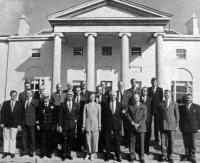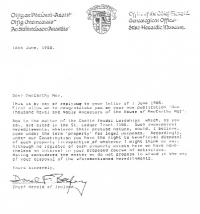The talented Mr MacCarthy ‘Mór’
Published in 20th-century / Contemporary History, General, Issue 3 (May/June 2011), Platform, Volume 19
President Mary Robinson meets members of the Standing Council of Irish Chiefs and Chieftains at Áras an Uachtaráin in October 1991. At the far left is Terence MacCarthy, ‘the MacCarthy Mór’, ‘prince of Desmond’. Just to the left of the president, carrying a briefcase, is MacCarthy’s granduncle, Terence Maguire, ‘the Maguire of Fermanagh’. The then chief herald of Ireland, Donal Begley, an official of the National Library of Ireland, is second from right, with a Bord Fáilte (Irish Tourist Board) representative at far right.
We in Ireland pride ourselves on the fact that our history ‘lives’, that the old and the new can often be found happily coexisting. On a fine October day in the Phoenix Park in 1991 there was an apparent demonstration of this rhyming of past and present. As a now fairly well-known photograph shows, then President Mary Robinson had invited members of the Standing Council of Irish Chiefs and Chieftains to a meeting in Áras an Uachtaráin. The icon of modern, liberal Ireland stood alongside proud representatives of ancient Gaelic families such as O’Brien, O’Conor Don, O’Neill of Clannaboy and MacGillycuddy of the Reeks. This was stated to be the first such gathering of Irish chiefs since the completion of the English conquest in the early seventeenth century.At the far left of the photograph, looking particularly pleased, stands one Terence MacCarthy, ‘the MacCarthy Mór’, and indeed ‘prince of Desmond’. Just to the left of the president, carrying a briefcase, is MacCarthy’s granduncle, Terence Maguire, ‘the Maguire of Fermanagh’ and also a ‘prince’. Lending his authority to the occasion, the then chief herald of Ireland, Donal Begley, an official of the National Library of Ireland, is second from right, with a Bord Fáilte (Irish Tourist Board) representative at far right.The Standing Council of Chiefs was apparently the brainchild of Maguire, aided and abetted by his grandnephew MacCarthy. Backed by a letter issued by the chief herald in 1988, Terence sold ‘Gaelic feudal titles’ to gullible followers for thousands of dollars apiece, and he also invented an allegedly ancient order called the Niadh Nask, which drew in more funds. Combined with gifts and payment of travelling and accommodation expenses, it is believed that the MacCarthy Mór enterprise earned about a million dollars, and possibly more.In addition to the names of many of the Irish chiefs, the membership roll of the Niadh Nask included General William Westmoreland and a brace of US military men, former taoisigh Charles Haughey and Albert Reynolds, the academic Katherine Simms and the author Peter Berresford Ellis. While not all members of the order would have been fully aware of its founder’s pretensions, it is only fair to point out that a book by Berresford Ellis published in 1999, Erin’s blood royal, championed MacCarthy’s cause and contained a foreword by the great man (a revised edition minus the foreword would be issued in 2002).While most of the other chiefs present in the 1991 photograph came from families with long-publicised claims to chiefship, MacCarthy, Maguire and a few others were somewhat new on the scene. The first chief herald of Ireland, Edward MacLysaght, had decided in the 1940s—perhaps unwisely, it could be said in retrospect—to involve himself in the work of distinguishing between real and fake claimants to Irish chiefship. As the Irish Constitution forbids the granting of titles, MacLysaght bestowed ‘courtesy recognition’ on some fifteen Gaelic chiefs, having checked their pedigrees carefully to establish that the claimants were the senior representatives of their lines. These chiefs MacLysaght entered in a Register of Chiefs (Clár na dTaoiseach).After MacLysaght’s retirement as chief herald in the 1950s, his successor, Gerard Slevin, did not add to or substantially amend the list of chiefs. Following his appointment in 1982, Chief Herald Donal Begley decided that it was time to expand the list of recognised chiefs, and between 1989 and 1995 he added seven names—O’Doherty of Inishowen, O’Long of Garranelongy, the aforementioned Maguire of Fermanagh and MacCarthy Mór, O’Carroll of Ely, O’Rourke of Breifne and MacDonnell of the Glens.Alas, it would become clear that the standard of research underlying these recognitions was somewhat less than that upheld by MacLysaght. With the exception of O’Doherty, which title is claimed by Ramón O’Dogherty of Spain and is backed by persuasive documentary evidence, there have been serious questions concerning the legitimacy of this batch of chiefs. These issues range from lack of clarity as to how a junior member of a line could claim a title usually the preserve of seniors to suspicions that some pedigrees had been ‘tweaked’, if not actually falsified.

The June 1988 letter of the chief herald—‘…we do not propose to stand in the way of your disposal of the aforementioned hereditaments’—which gave the green light to Terence MacCarthy ‘Mór’ to sell ‘Gaelic feudal titles’ to gullible followers for thousands of dollars apiece.
These doubts were most marked in the case of Terence MacCarthy, who used his scholarly training to manufacture an obfuscatory fog of entitlement based on ‘Brehon law’ and ‘tanistry’. The present writer—and, it would later emerge, others too—decided to put Terence’s claim of aristocratic descent to the test in the late 1990s. Research in conventional genealogical sources, particularly census, birth, marriage, death and church records, established that Terence’s ancestors were ordinary Belfast folk with no indication of chiefly status. It was found that the pedigree of this Belfast family had simply been grafted on to that of a branch of the aristocratic Munster MacCarthys, constituting an effective forgery. Furthermore, it was noted that, like most bearers of the surname in Ulster, Terence’s ancestors were more likely to have been Scottish McCartneys than Munster MacCarthys.The writer considered that he had gathered enough hard evidence by June 1999 to issue a signed report exposing the MacCarthy Mór hoax. This was taken up by the Irish edition of the Sunday Times, which published a hard-hitting exposé of Terence and his associate Andrew Davison, ‘count of Clandermond’. While the two men were in the habit of travelling for lectures and functions to Ireland, and particularly to the United States, where they had many wealthy followers, the duo were by this stage ordinarily resident in Morocco.Events moved quickly after this public exposure, so that in July 1999 the office of the chief herald announced that it had stripped MacCarthy of chiefly recognition, revealing that it had been considering the matter for some years. Terence himself ‘abdicated’ as MacCarthy Mór in October, pleading ‘complete nervous collapse’ (he still lives in Morocco, where he is now involved in the art business). Embarrassed followers realised their mistake and repudiated MacCarthy, for a time forlornly casting about for a replacement. An element of comedy was added to the farce with a notice from Terence’s bodyguard, the Galloglass Guard, headed by the ‘Baron Castleshort’, that it was placing those involved in exposing Terence under ‘surveillance’, but thankfully this threat came to nothing.Unfortunately, the affair had more serious consequences, not least in terms of the reputational damage to Irish heraldry and genealogy and in particular to the office of the chief herald of Ireland. The attorney-general had been asked for advice on how to deal with the matter, and in 2002 delivered something of a bombshell in reply, indicating that the office of the chief herald had legal authority neither to recognise chiefs nor to engage in its primary business of granting arms. The attorney-general’s alarming advice was followed by an announcement by the National Library of Ireland in 2003 that the chief herald would no longer be involved with recognising chiefs, leaving unresolved the matter of who is or is not genuine.While it is considered that the implementation of the National Cultural Institutions Act in 2005 empowered the chief herald to resume granting arms, it remains the case that all arms grants from 1943 until that year, including those to US presidents Kennedy and Clinton and Irish presidents Robinson and McAleese, are lacking in legal validity. It is doubtful whether a government and legislature currently struggling to stave off national bankruptcy would have much time to devote to passing retrospective heraldic legislation, and it may be asked whether the state should not simply end its involvement with granting arms. Such is the enduring prestige and appeal of heraldry, however, that it is likely that chief heralds will continue to be appointed within the National Library, although there are no plans to grant arms to the visiting President Obama on the strength of his Irish Kearney ancestry.Rather like the fictional ‘talented Mr Ripley’, Terence MacCarthy evidently believed that it was better to be a fake somebody than a real nobody. As we rue the national self-deception that underlay the illusion of unlimited growth and wealth engendered by the Celtic Tiger, we should be able to see that in the realm of heraldry and genealogy as well those who should have known better were led astray by one of the world’s most remarkable and successful hoaxers, the talented Mr MacCarthy ‘Mór’. HI
Seán J. Murphy is an Adult Education Genealogy Teacher in University College Dublin.
Further reading:S.J. Murphy, Twilight of the chiefs: the MacCarthy Mór hoax (Bethesda, 2004).Irish Chiefs, http://homepage.eircom.net/ ~seanjmurphy/chiefs/.


















